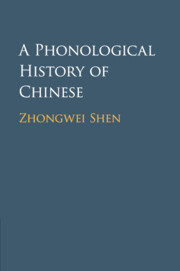Book contents
- A Phonological History of Chinese
- A Phonological History of Chinese
- Copyright page
- Contents
- Figures
- Tables
- Foreword by William S-Y. Wang 王士元
- Preface
- Major Periods of Chinese History
- Locations of Ancient Capitals of China
- Part I The Keys to Traditional Phonology
- 1 An Introduction to Chinese Historical Phonology
- Part II Old Chinese
- Part III Middle Chinese
- Part IV The Beginnings of Mandarin
- Part V A New Standard
- Part VI Toward Modern Mandarin
- References
- Index
1 - An Introduction to Chinese Historical Phonology
from Part I - The Keys to Traditional Phonology
Published online by Cambridge University Press: 09 June 2020
- A Phonological History of Chinese
- A Phonological History of Chinese
- Copyright page
- Contents
- Figures
- Tables
- Foreword by William S-Y. Wang 王士元
- Preface
- Major Periods of Chinese History
- Locations of Ancient Capitals of China
- Part I The Keys to Traditional Phonology
- 1 An Introduction to Chinese Historical Phonology
- Part II Old Chinese
- Part III Middle Chinese
- Part IV The Beginnings of Mandarin
- Part V A New Standard
- Part VI Toward Modern Mandarin
- References
- Index
Summary
The introductory chapter mainly provides two kinds of information. One is the explanation of some basic terminologies used in the traditional study of Chinese phonology. The other is various source materials that are used in the study of Chinese historical phonology. These two kinds of information are very much interrelated. Due to the logographic nature of the Chinese writing system, the study of a historical sound system is a rather difficult task. Despite such difficulty, Chinese scholars have been diligently analyzing the phonological system of Chinese for more than fifteen hundred years. In the long history of Chinese scholarship, the achievements of phonological studies are represented by a large number of terminologies. Since all these achievements were made at the absence of an alphabetical spelling system, what has been achieved by and large is the collection of categorical information, such as how many tones, how many initials, and how many different categories of finals a given dialect or standard has. The terminologies are the keys to understanding traditional phonology. They are frequently used in the phonological studies for all periods: Old Chinese, Middle Chinese, Old Mandarin, and even Modern Mandarin.
Keywords
- Type
- Chapter
- Information
- A Phonological History of Chinese , pp. 3 - 56Publisher: Cambridge University PressPrint publication year: 2020



